投稿日:
更新日:
History and culture liven up ShinshuTraditional tea friends
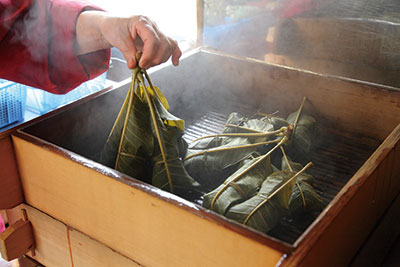
I love drinking teaShinshupeople. There may be some people who have been pouring more and more and more and end up staying for a long time. This also conveys the desire to "relax and relax."ShinshuIt is one of the unique hospitality.
There are a wide variety of tea treats, including pickles and flour, but when it comes to sweets, Japanese sweets are the best. The sweets that have not changed since ancient times and are commonplace in homes, live up to the history and culture unique to the local land.
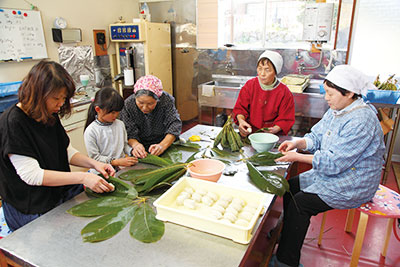
A traditional tradition that the region wants to pass on and pass on
"Hoobamaki" is a local sweet from Kiso that can be enjoyed only in early summer
Hoobamaki was made as a snack during the busy farming season in June, when the mountains are bright and green, and as a celebration of the late-month Tango Festival. This is a traditional Kiso region sweet made with broom leaves, which have a sturdy, sterilizing effect and has a subtle sweet fragrance.
"The men are the ones who collect the leaves, and the women and children are the role of making and wrapping the dumplings. In the past, it was common for one house to make about 200, so it was an event that was attended by the whole family," says Noguchi.

The dumplings are now smaller so that they are easier to eat, but in the past they were about twice the size so that they could eat them full.
"When we were children, the skin was thick, and just taking a bite wouldn't bring out the bean paste (laughs). The skin gradually got hard, so we grilled it in the hearth and ate it," the mothers were excited.
Nowadays, they can be purchased at confectionery shops and roadside stations in the Kiso area, but this is the only time you can enjoy it. Please try to experience the seasons of Kiso with Hoobamaki.

Yumejin City (Kiso Town)
Representative: Noguchi Hiroko
In 1987, he founded "Yumejin City" with local mothers, and in addition to manufacturing and selling Kiso specialty products such as Hoobamaki and Sunki, he is also a director of the NPO Furusato Koso Kiso, and is involved in the local cuisine and historical and culture of the region.

The unique sweetness and flavor only produced by Oni Walnut
Matsumoto's tea sweet "Masami Sugar" was born from the culture of the castle town
Matsumoto is a castle town where famous waters gush everywhere. The dry climate has helped create a habit of making tea frequently, and a unique tea-cooking culture has also been cultivated. "Masami Sugar" was born in Matsumoto in the early Taisho era.
When first released, the walnut pattern on the edge resembles a kabuki kurumi, so it is called "Kabuki walnut" and isGinzaIt was also sold at the Kabukiza. In the early Showa period, the master Urasenke Tanjisai named "Masami Sugar" because it was a name that was more appropriate for tea ceremony sweets.

"We wanted to make cheap and delicious food so that many people would love it. So we focused on Oni Walnut, which was a side job for farmers at the time," said Watanabe.
"Because Oni Walnuts have become precious, we also considered replacing them with different types of walnuts, almonds, peanuts, etc. However, they didn't give off this unique sweetness and flavor. I guess it was a fateful encounter by chance." "Masami Sugar" may be a famous confectionery that could only be born in Matsumoto.
Made with craftsmanship and special machines! Until the flavored sugar is formed
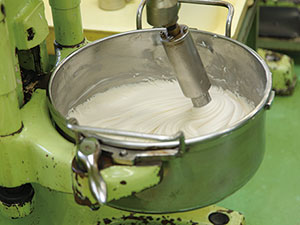
Whipped sugar
The sugar is made from A-rice, which is the same quality as rock sugar and is easily dissolved. First, boil the sugar and make it into a candy shape, then mix it with a blender. Once it's filled with air and is white and fluffy, add the Oni Walnut.
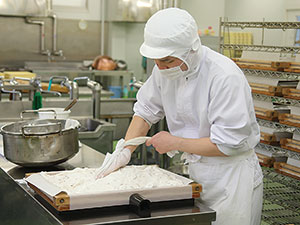
Spread it on a wooden mold
After mixing the oni walnuts and sugar well, pour them into a special wooden mold and spread them flat. The fabric is sticky, making it difficult to work on machines, and this is a task that can only be done by hand by craftsmen.
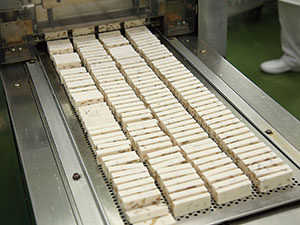
Cut and dry
After pressing it harden overnight with a wooden mold, start cutting. The machine that cuts the finest sugar is 100% developed in-house, and the key point is that it can be cut with spaced spaces to make it easier to dry.

Kaiundo (Matsumoto City)
Representative Director Watanabe Kimio
It has been over 130 years since I moved from a kimono dealer to a confectionery business in 1887. He is the fourth generation president of a long-established company that carries out confectionery rooted in the community. Sweets are originally foods that give off seasonal flavor. Even as various technologies evolve, he says he wants to cherish that culture.

The commitment to manufacturing methods and materials that remain the same even after 100 years
Shinshu"Misuzu Ame" is a Japanese-style jelly made from Ueda, packed with seasonal seasons.
The flood that occurred in Fukagawa, Tokyo in 1908, began the initiation of Iijima Shoten, a grain dealer, began to operate the confectionery business.
When asked about using flooded rice, Iijima Shinzaburo, the fifth generation, extracted the starch from rice to produce starch syrup, and then used the starch syrup.ShinshuIn order to create unique products, Misuzu Ame was born, which incorporates local fruits and agar. It's also surprising that the manufacturing process has remained almost the same since then, and manufacturing is almost entirely done by hand.

"There's no machine that's better than the hands of a craftsman. There are some craftsmen who have been wrapping oblates for over 30 years," says Tanaka, who is in charge of public relations. He apparently had a strong commitment to the fruit he chose from back then.
"Choosing ingredients is the core of our product creation. When eaten raw, sweet and delicious things are not necessarily suitable. We need to determine the changes in taste after processing and whether they have an elegant sour taste," and we can see why they continue to be loved for over 100 years.
All traditional manufacturing methods are handmade! Until Misuzu candy is made
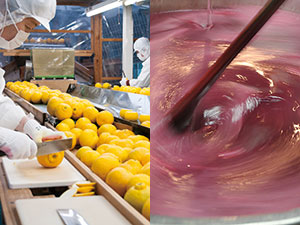
Fruit processing and candy kneading
Domestic fruits are carefully processed and juice is squeezed. Add starch syrup, sugar and agar to the juice and simmer, knead it to avoid any signs of colour and aroma, then pour it into a mold to make fresh candy.

Candy cut
Cut the raw candy with a large knife and shape it into Misuzu candy. Cutting jelly-like raw candy requires skilled craftsmanship to cut without rippling because it is difficult to distribute force.

Candy roll
To finish, hand-wrapped 0.02mm thin oblate is wrapped around each of the raw candy. This keeps the fresh candy fresh and keeps it fresh.

Iijima Shoten (Ueda City)
Tanaka Hiroyuki
Tanaka said that while he was looking for a job in Tokyo, he found his hometown of Iijima Shoten at a company information session, and that he felt nostalgic about it. "I am one of the people who were fascinated by Misuzu candy," she smiles.















